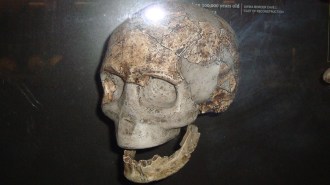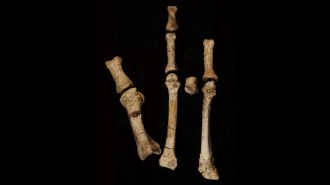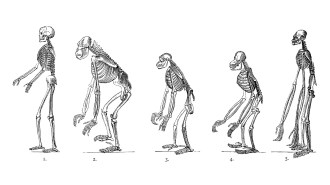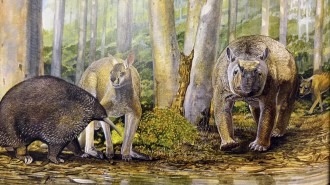Fossil Sparks
New finds ignite controversy over ape and human evolution
Fifty years ago, British anatomist Wilfrid Le Gros Clark explained in a lecture why evolutionary scientists argue so vehemently about how ancient apelike and humanlike creatures eventually gave way to modern humans. “Every fossil relic which appears to throw light on connecting links in man’s ancestry always has, and always will, arouse controversy,” he stated, “and it is right that this should be so, for it is very true that the sparks of controversy often illuminate the way to truth.”
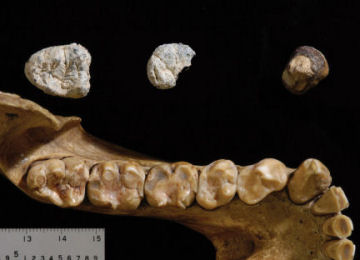
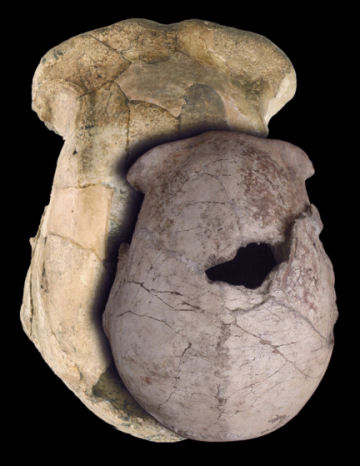
Le Gros Clark was no stranger to wringing the truth out of bits of fossilized skeleton. In 1953, he assisted in unmasking the infamous Piltdown hoax. For more than 40 years, researchers had assumed that skull and jaw fragments collected from a British gravel pit came from a previously unknown early human species. The finds actually consisted of an orangutan’s lower jaw and a modern man’s skull.
But Le Gros Clark knew that genuine fossil discoveries ignite brighter sparks of controversy than any cranial con job ever could. Given limited evidence about long-gone populations of our predecessors, researchers devise competing evolutionary scenarios that are often difficult to disprove and that can easily accommodate whatever ancient bones turn up next.
Scientific reactions to the latest fossil finds and analyses underscore Le Gros Clark’s point. Consider a handful of 10-million-year-old teeth recently unearthed in Ethiopia and attributed by their discoverers to a direct ancestor or close relative of the gorilla. If the scientists are right, ancient gorillas initially diverged from human ancestors more than 10 million years ago, several million years before DNA-based analyses date the split. However, some researchers regard the ancient teeth as remnants of an extinct ape that probably bore no relation at all to gorillas.
Further along evolution’s path lie new fossil finds in Kenya that tell a disputed story about the emergence of direct human ancestors. Scientists who uncovered the ancient braincase and partial upper jaw say that this evidence, combined with prior fossils, indicates that two Homo species lived simultaneously in eastern Africa from about 1.9 million to 1.4 million years ago. In this scenario, one species died out and the other led to modern humans. But one prominent anthropologist rejects that conclusion, placing both new fossils in a single species that preceded Homo sapiens.
Finally, a research team recently argued that its new analysis of fossil teeth from sites in and beyond Africa supports the controversial notion that human ancestors trekked from Africa into Asia well before 2 million years ago and then colonized Europe from Asia. Critics of the work say that more fossil evidence is needed to overturn this team’s conclusion that Africans migrated into Asia no more than 1.8 million years ago and eventually settled Europe as well.
“It’s possible that hominids [the fossil ancestors of people] left Africa as early as 2 million years ago,” says anthropologist Tim White of the University of California, Berkeley, “but it’s hard to untangle the geographic patterns of their movements.”
Pieces of ape
In February 2006, a field assistant working with fossil hunters in Ethiopia’s Chorora Formation, a series of sediment layers dated at between 10 million and 11 million years old, found an ape’s canine tooth. One year later, the researchers returned to the site and found eight more teeth from the same ancient-ape species, which they dubbed Chororapithecus abyssinicus.
Anthropologist Gen Suwa of the University of Tokyo and his coworkers see signs of gorilla ancestry in the fossils. Computerized tomography scans show that the gorilla-size teeth contain thick enamel suitable for shredding foods such as stems and leaves, the scientists report in the Aug. 23 Nature. Modern gorillas display slightly thinner dental enamel but eat the same types of vegetation. Crests on the chewing surfaces of the ancient teeth look like early versions of the more-pronounced crests in present-day gorillas, the researchers note.
Chororapithecus represents either an early, direct ancestor of gorillas or a dead-end primate that happened to evolve gorillalike teeth, in their view.
Precious few African-ape fossils from between 12 million and 7 million years ago have been recovered. Some scientists have speculated that the line of ancestral apes from which chimpanzees, gorillas, and people emerged came from Asia and Europe and later spread into Africa. Chororapithecus suggests instead that this evolutionary process began in Africa, Suwa’s team holds.
Moreover, the new finds indicate that an evolutionary split of direct gorilla ancestors from apelike precursors of people occurred more than 10 million years ago, the investigators say. In contrast, analyses of modern human and ape DNA place that split at about 8 million years ago.
DNA studies also estimate that the split of chimp from human ancestors happened 6 million years ago, and that the human-orangutan split occurred about 14 million years ago.
Given the age of Chororapithecus, Suwa’s group puts the human-orangutan split at roughly 20 million years ago, the human-gorilla split at about 12 million years ago, and the human-chimp split at 9 million years ago.
Suwa’s conclusion that the Ethiopian fossils come from either a gorilla ancestor or an evolutionary cousin of ancient gorillas makes sense, remarks anthropologist Michel Brunet of the University of Poitiers in France. The teeth of the oldest known hominid, which lived about 7 million years ago, look “completely different” from those of Chororapithecus, Brunet says.
The French researcher’s team unearthed the ancient hominid’s nearly complete skull in central Africa (SN: 7/13/02, p. 19). Many investigators accept that specimen as the oldest fossil ancestor of people, but others regard it as an ancient ape.
Chororapithecus also has a disputed identity. The new find could easily have come from an ancient ape that had nothing to do with gorilla ancestors but evolved one or a few gorillalike dental traits on its own, says anatomist John Kelley of the University of Illinois at Chicago. The Ethiopian fossils have virtually nothing in common with the teeth of modern gorillas, aside from crests on their chewing surfaces that would have aided in grinding up vegetation, Kelley asserts.
Suwa will keep looking for more pieces of ape. “There is no way to predict future finds at Chorora,” he says.
Separate paths
Scientists have long regarded Homo habilis and Homo erectus as the first two links in an evolutionary chain that ended with the appearance of modern humans. In this view, the relatively small-brained H. habilis evolved about 2 million years ago from earlier African hominids. It evolved into the larger-brained H. erectus by around 1.6 million years ago.
New fossil finds challenge that portrait of our distant ancestors, say anatomist Fred Spoor of University College London and his coworkers. H. habilis and H. erectus evolved independently of each other, Spoor’s team contends. Rather than one species giving way to the next, both species lived simultaneously in eastern Africa for roughly 500,000 years, the scientists report in the Aug. 9 Nature.
That conclusion rests on an analysis of two fossils unearthed in Kenya in 2000. One fossil consists of a piece of upper jaw. Chemical studies of volcanic-ash layers above and below the find place its age at 1.44 million years.
The jaw contains six teeth, running from a canine tooth in front to a wisdom tooth in back. The size and shape of the teeth, as well as evidence that the roof of the mouth was wide and shallow, align the fossil with H. habilis, according to Spoor’s group.
The second fossil consists of a small braincase with an estimated age of 1.55 million years. This specimen bears several traits unique to H. erectus, including a bony ridge running over the top of the head and a delicate jaw joint.
Since the two species coexisted in the same region for such a long time, each must have had separate origins between 3 million and 2 million years ago, the researchers contend. Few hominid fossils have turned up from that period.
H. sapiens apparently evolved from H. erectus, possibly via an intermediate species, in Spoor’s view. H. habilis was a sister species of H. erectus and eventually hit an evolutionary dead-end.
The newly discovered fossil brain case belonged to the smallest known H. erectus individual. The find thus indicates a size range for H. erectus fossils of eastern Africa that almost equals that for modern gorillas. The gorilla pattern reflects males’ large size advantage over females, a condition that may also have applied to male and female H. erectus, says study coauthor Susan C. Antón of New York University.
If so, then H. erectus males may have mated with multiple females and tried to monopolize access to them, as male gorillas do.
Such conclusions don’t sit well with Berkeley’s White. He classifies both new fossil finds as H. erectus and as valuable additions to the fossil record, but hardly the stuff of major evolutionary revisions.
White sees Spoor’s paper as part of an ongoing scientific movement to increase the number of species and evolutionary branches on the hominid family tree. In contrast, White argues that early hominids usually evolved from one species to the next, without branching into multiple species (SN: 4/15/06, p. 227).
“What’s interesting is how few hominid lineages there were,” White says. He regards early hominids, or australopithecines, as one such lineage that evolved into a second, the Homo lineage, more than 2 million years ago. A group of species called robust australopithecines, which died out 1.2 million years ago, qualifies as a third hominid lineage, in his view.
Eastern origins
Teeth sometimes tell contested evolutionary tales. That adage applies to a new analysis of hominid teeth conducted by researchers who have found 400,000-year-old skeletons of Neandertal ancestors in Spain and the 1.77-million-year-old remains of an early Homo species in central Asia (SN: 9/22/07, p. 179). The scientists suspect that, perhaps 2 million to 3 million years ago, Asian hominids began to move west, exerting a huge impact on the evolution of Neandertals and other Homo species in western Asia and Europe.
That suggestion contrasts with the traditional view that hominids left Africa around 1.8 million years ago and evolved into species such as Neandertals after reaching Europe and other locales. Asian hominids of the time evolved separately and eventually died out, according to this perspective.
A team led by Maria Martinón-Torres of the National Center of Human Evolution Studies in Burgos, Spain, has examined 51 anatomical traits on more than 5,000 hominid teeth. Fossils came from African australopithecines and from African, Asian, and European Homo species, including H. sapiens.
Up to the appearance of Neandertals in Europe around 130,000 years ago and modern H. sapiens in Africa 200,000 years ago, dental features fall into two geographic categories, the researchers report in the Aug. 14 Proceedings of the National Academy of Sciences. African teeth display one suite of characteristics, while Asian and European teeth share a different dental signature.
Asian hominids apparently made a substantial genetic contribution to the evolution of later European species, the scientists say.
However, anthropologist David Frayer of the University of Kansas in Lawrence says that Martinón-Torres and her coworkers need larger numbers of fossils, especially of H. sapiens, to make their case. Moreover, the researchers didn’t consider several dental traits that differ between Neandertals and Asian hominids, he argues.
To paraphrase Le Gros Clark, let the sparks of controversy fly. They may burn brightly enough to illuminate a bit of evolutionary truth.


